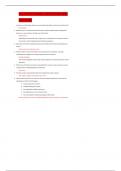611 PATHO EXAM 2 QUESTIONS AND
ANSWERS
Parkinson and Huntington diseases are associated with defects in which area of the brain?
Basal ganglia
1. Maintenance of a constant internal environment and the implementation of behavioral
patterns are main functions of which area of the brain?
Hypothalamus
Hypothalamic function falls into 2 major areas: 1) maintenance of a constant internal
environment, and 2) implementation of behavioral patterns.
2. What parts of the brain mediate the expression of affect, both emotional and behavioral
states?
Limbic system and prefrontal cortex
3. Reflex activities concerned with heart rate, blood pressure, respirations, sneezing,
swallowing, and coughing are controlled by which area of the brain?
Medulla oblongata
The medulla oblongata makes up the myelencephalon and is the lowest portion of the
brainstem.
4. Which area of the brain assumes the responsibility for conscious and unconscious muscle
synergy and for maintaining balance and posture?
Cerebellum
5. The brain receives approximately what percentage of the cardiac output?
20% or 800 to 1000 ml of blood flow per minute
6. What evidence does the nurse expect to see when a patient experiences trauma to the
hypothalamus? (select all that apply)
A. Uneven expression of mood
B. Unstable blood glucose levels
C. Poor regulation of body temperature
D. Visual disturbances such as blurred vision
E. N/V and symptoms of gastroesophageal reflux disease
Uneven expression of mood, unstable blood glucose levels, and poor temp regulation
, The hypothalamus forms the base of the diencephalon. Hypothalamic function controls
autonomic nervous system function, regulation of body temp, endocrine function
(glucose levels), and regulation of emotional expression.
7. What is the first defense of our bodies?
Skin and mucous membranes
8. Which action is the purpose of the inflammatory process?
To prevent infection of the injured tissue
If the epithelial barrier is damaged, then a highly efficient local and system response
(inflammation) is mobilized to limit the extent of damage, to protect against infection,
and to initiate the repair of damaged tissue.
9. What are the 4 cardinal signs of infection?
Edema (tumor), warmth (calor), redness (rubor), and pain (dolar).
There is a 5th sign known as loss of function (functio laesa) but Dr. Wunderlich did not
mention this.
10. Which type of white blood cell is first to arrive at the site of infection?
Leukocytes
11. What causes the edema that occurs during the inflammatory process?
Increased capillary permeability
The increased flow and capillary permeability result in a leakage of plasma from the
vessels, causing swelling in the surrounding tissue and is solely responsible for
inflammation-induced edema.
12. What process causes heat and redness to occur during the inflammatory process?
Vasodilation of blood vessels
The increased blood flow, as a result of vasodilation and increasing concentration of red
cells at the site of inflammation cause locally increased warmth and redness.
13. The chemotactic factor affects the inflammatory process by?
Directing leukocytes to the inflamed area
Two chemotactic factors, neutrophil chemotactic factor (NCF) and eosinophil chemotactic
factor of anaphylaxis (ECF-A), are released during mast cell degranulation.
NCF attracts neutrophils (a type of leukocytes), and ECF-A attracts eosinophils to the site
of inflammation.
14. What is pain mediated by?
Histamines, bradykinins, leukotrienes, and prostaglandins
15. The function of opsonization related to the complement cascade is to:
, Tag the pathogenic microorganisms for destruction by neutrophils and macrophages. C3b
adheres to the surface of a pathogenic microorganism and serves as an efficient opsonin.
Opsonins are molecules that tag microorganisms for destruction by cells of the
inflammatory system, primarily neutrophils and macrophages.
16. During phagocytosis what is occurring during the step referred to as opsonization?
Phagocytes recognize and adhere to the bacteria
During phagocytosis, opsonization involes only the recognition and adherence of
phagocytes to bacteria.
17. What is the correct sequence of phagocytosis?
Recognition (opsonization), engulfment, fusion, and destruction
Once the phagocytic cell enters the inflammatory site, the only correct sequence of
phagocytosis involves opsonization or recognition of the target and adherence of
the phagocyte to it, engulfment, or ingestion or endocytosis, and the formation of
phagosome, fusion with lysosomal granules within the phagocyte and destruction of the
target.
18. Which manifestations of inflammation is systemic?
Fever and leukocytosis
The only primary systemic changes associated with the acute inflammatory response are
fever, leukocytosis (a transient increase in circulating leukocytes), and increased levels in
circulating plasma proteins.
19. The acute inflammatory response is characterized by fever that is produced by the
hypothalamus being affected by?
Endogenous pyrogens
Fever-causing cytokines are known as endogenous pyrogens.
20. When considering white blood cell differentials, acute inflammatory reactions are related to
elevations of which leukocyte?
A. Monocytes
B. Eosinophils
C. Neutrophils
D. Basophils
Neutrophils
Only neutrophils are the predominant phagocytes in the early inflammatory site, arriving
within 6-12 hours after the initial injury, they ingest (phagocytose) bacteria, dead cells,
and cellular debris at the inflammatory site.




